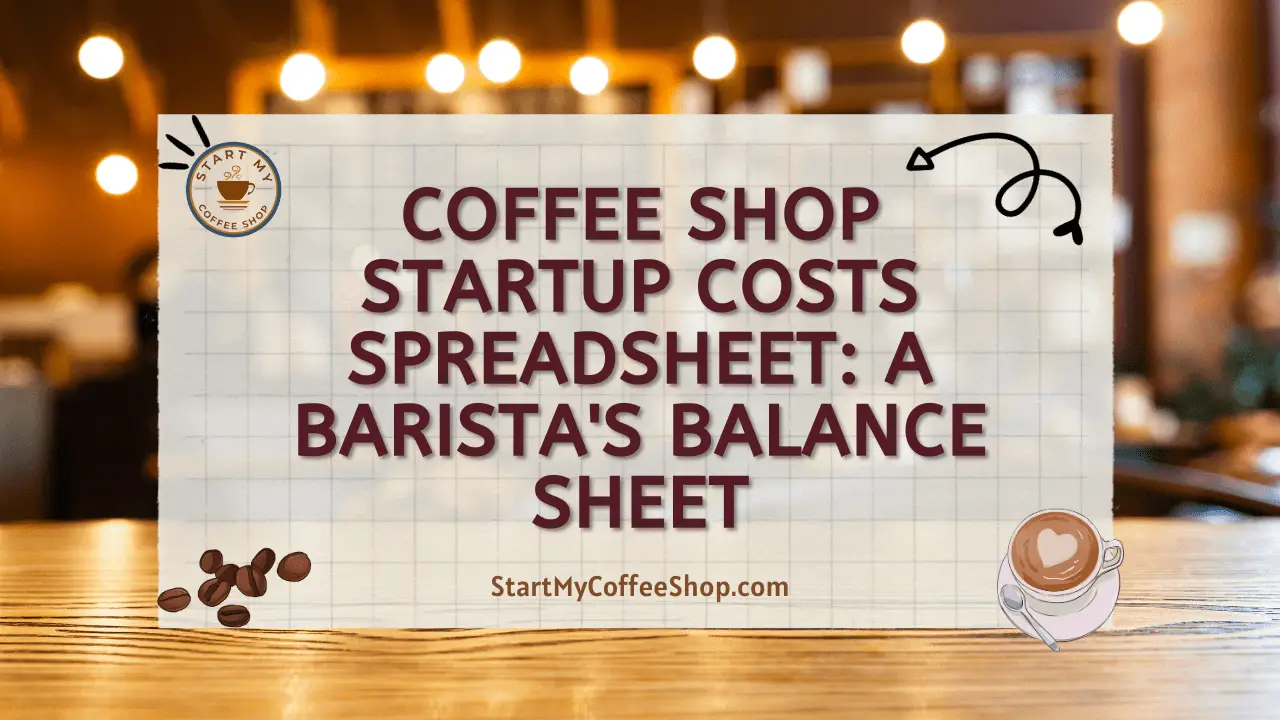Starting a coffee shop is an exciting venture for aspiring entrepreneurs and coffee enthusiasts alike. However, before you can brew your first cup of joe, it’s essential to understand and plan for the financial aspects of your business. One valuable tool that can aid you in this process is a coffee shop startup costs spreadsheet.
A coffee shop startup costs spreadsheet is a vital tool for entrepreneurs. It provides financial clarity, helps with budgeting and forecasting, and ensures scalability. Organizing expenses and projecting revenue, enables effective planning and decision-making, setting your coffee shop up for progress.
In this article, I will delve into the significance of a startup costs spreadsheet, its key components, and how to create one to ensure your coffee shop venture gets off to a great start.
Why Use a Coffee Shop Startup Costs Spreadsheet?
When embarking on a coffee shop startup, a well-designed spreadsheet can serve as a roadmap for your financial planning. Here’s why utilizing a startup costs spreadsheet is crucial:

Financial Clarity
Financial clarity is essential when starting a coffee shop, and a coffee shop startup costs spreadsheet plays a crucial role in achieving it. By using a spreadsheet, you can identify and track all the necessary costs associated with starting your coffee shop, providing you with a comprehensive understanding of your financial obligations.
The spreadsheet acts as a centralized tool where you can list and organize various expenses such as equipment purchases, construction or renovation costs, permits and licenses, marketing expenses, employee salaries, rent, utilities, and more. By meticulously detailing these costs in the spreadsheet, you create a clear and transparent picture of the financial resources needed to establish your coffee shop.
Moreover, a spreadsheet enables you to categorize and break down expenses, allowing you to see the individual components of your financial obligations. This level of granularity helps you prioritize expenses, make informed decisions, and allocate resources accordingly.
Read more about: Coffee Shop Startup Costs Forecasting: The Art of Financial Brewing
With a coffee shop startup costs spreadsheet, you can track the costs incurred throughout the process, from initial setup to ongoing operations. This tracking ensures that you stay within your budgetary limits and identifies any areas where adjustments may be necessary. It provides a visual representation of where your money is going, which is invaluable for monitoring financial health and making strategic adjustments when needed.
The spreadsheet facilitates comparison and analysis. By organizing costs in one place, you can easily compare estimates from different suppliers or service providers, evaluate the most cost-effective options, and negotiate better deals. It empowers you to make informed financial decisions by having a comprehensive overview of the expenses associated with your coffee shop.
Budgeting and Forecasting
Budgeting and forecasting are vital aspects of starting a coffee shop, and a coffee shop startup costs spreadsheet proves invaluable in this regard. The spreadsheet allows you to organize and categorize your expenses while also providing a platform to estimate future revenue.
By leveraging this tool, you can create realistic budgets and financial projections, empowering you to make informed decisions and increase your chances of securing potential funding.
With a coffee shop startup costs spreadsheet, you can input your projected sales, taking into account factors such as location, target market, pricing strategy, and competition. By considering these variables, you can develop revenue projections that align with your business goals. This process helps you anticipate the financial performance of your coffee shop, giving you a clearer understanding of your expected income.
On the expense side, the spreadsheet enables you to allocate resources efficiently and set realistic budgets for various aspects of your coffee shop. By having a detailed overview of expenses such as rent, utilities, employee salaries, marketing costs, and inventory purchases, you can ensure that your budget aligns with your revenue projections and overall financial goals.
Moreover, the ability to create financial forecasts using the spreadsheet allows you to analyze different scenarios and make strategic decisions. By adjusting variables such as pricing, marketing efforts, or operational costs, you can assess the potential impact on your bottom line. This forecasting capability helps you evaluate the feasibility of different strategies, identify potential risks, and make necessary adjustments to maximize profitability.
The availability of accurate budgets and financial projections also enhances your credibility when seeking funding from investors or lenders. A well-designed coffee shop startup costs spreadsheet showcases your understanding of the financial aspects of your business and provides concrete evidence of your planning and forecasting abilities. It increases the confidence of potential funders in your venture and improves your chances of securing the necessary capital.
Scalability and Flexibility
Scalability and flexibility are essential considerations when starting a coffee shop, and a coffee shop startup costs spreadsheet excels in adapting to the evolving nature of your business. As your coffee shop progresses and undergoes changes, the spreadsheet can be easily updated to accommodate shifts in expenses, sales projections, and other financial variables.
The spreadsheet serves as a dynamic tool that allows you to make adjustments as your coffee shop grows. For example, if you decide to expand your menu offerings or introduce new product lines, you can update the spreadsheet to reflect the additional costs associated with purchasing new ingredients or equipment. Similarly, if you experience changes in rent, utilities, or labor expenses, the spreadsheet can be modified to incorporate these variations, providing an accurate representation of your financial obligations.
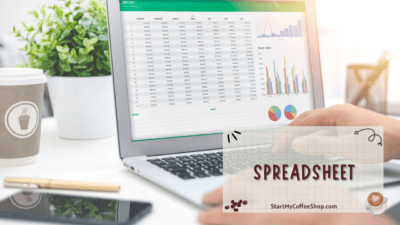
Moreover, as you gather more data and gain a better understanding of your coffee shop’s performance, you can refine your sales projections in the spreadsheet. By analyzing historical sales data, monitoring trends, and assessing customer feedback, you can make more accurate predictions about future revenue. Updating the sales projections in the spreadsheet ensures that your financial planning remains aligned with the actual performance of your coffee shop.
The flexibility of the coffee shop startup costs spreadsheet also allows you to explore different scenarios and evaluate their financial impact. For instance, you can simulate the effects of increasing or decreasing prices, adjusting marketing strategies, or expanding your seating capacity. By inputting these variations into the spreadsheet, you can assess their implications on your overall financial health and make informed decisions about the future direction of your coffee shop.
Read more about: Coffee Shop Startup Business Plan: Unveiling Caffeinated Ventures
Key Components of a Coffee Shop Startup Costs Spreadsheet
A well-structured coffee shop startup costs spreadsheet should include the following components:
Pre-Opening Expenses
Pre-opening expenses are a crucial aspect of starting a coffee shop, and a coffee shop startup costs spreadsheet helps you meticulously plan and manage these initial financial obligations. Here are some key pre-opening expenses that should be included in your spreadsheet:
- Market research and feasibility studies play a vital role in understanding the potential demand, competition, and target market for your coffee shop. Allocating funds for comprehensive research and analysis ensures that you make informed decisions and lay a strong foundation for your business.
- Legal fees and permits are essential to ensure compliance with local regulations and licensing requirements. These expenses cover obtaining necessary permits, licenses, and legal documentation, including business registration, health permits, and food service licenses.
- Interior design and construction costs encompass creating an inviting and functional space for your coffee shop. This includes expenses related to architectural design, renovation, furniture, fixtures, lighting, flooring, and signage. Investing in a visually appealing and comfortable environment contributes to a positive customer experience.
- Equipment and machinery procurement involves purchasing the necessary tools to run your coffee shop efficiently. This includes espresso machines, grinders, brewing equipment, refrigeration units, POS systems, and other essential items. Researching reputable suppliers and comparing costs is crucial to ensure you obtain quality equipment within your budget.
- Initial inventory and supplies encompass the procurement of coffee beans, tea leaves, syrups, milk, disposable cups, napkins, and other items necessary for your daily operations. Accurately estimating your initial inventory needs and pricing is vital to avoid excessive waste or stockouts.
Operational Expenses
Operational expenses are ongoing costs that you need to consider when running a coffee shop, and a coffee shop startup costs spreadsheet helps you effectively manage and track these financial obligations. Here are key operational expenses that should be included in your spreadsheet:
- Rent and utilities encompass the costs associated with leasing your coffee shop space, including monthly rent, property taxes, and common area maintenance fees. Additionally, utilities such as electricity, water, gas, internet, and phone services are essential for the day-to-day operations of your coffee shop.
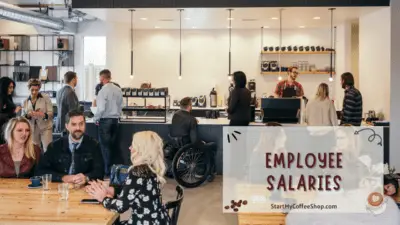
- Employee salaries and benefits are a significant component of operational expenses. This includes wages for baristas, managers, and other staff members, as well as expenses related to employee benefits, such as health insurance, retirement plans, and paid time off. It’s crucial to allocate a sufficient budget for attracting and retaining qualified and motivated employees.
- Marketing and advertising expenses are necessary to promote your coffee shop and attract customers. These costs include digital and traditional advertising, social media campaigns, website development and maintenance, signage, printed materials, loyalty programs, and collaborations with local influencers or businesses.
- Insurance and licenses are essential for protecting your coffee shop and complying with legal requirements. Expenses in this category may include liability insurance, workers’ compensation insurance, property insurance, and licenses for food service, alcohol sales (if applicable), and music rights.
- Maintenance and repairs encompass the regular upkeep and occasional repairs of your coffee shop equipment, fixtures, and premises. This includes costs for preventive maintenance, equipment servicing, plumbing, electrical work, pest control, and general repairs to ensure a safe and functional environment for both staff and customers.
Read more about: Coffee Shop Start-up Equipment Cost: Equipment Essentials
Fixed and Variable Costs
Understanding and managing both fixed and variable costs is essential for running a coffee shop, and a coffee shop startup costs spreadsheet helps you analyze and control these different types of expenses. Here’s an overview of fixed and variable costs that should be included in your spreadsheet:
- Fixed costs are expenses that remain constant regardless of the sales volume or production level of your coffee shop. These costs include items such as rent, insurance premiums, property taxes, and loan payments. Whether your coffee shop is bustling with customers or experiencing a slow day, these expenses remain the same. By accurately tracking and budgeting for fixed costs in your spreadsheet, you gain a clear understanding of your baseline expenses and can plan accordingly.
- On the other hand, variable costs fluctuate in direct proportion to the level of sales or production. They are directly tied to the volume of business activity in your coffee shop. Variable costs can include ingredients and supplies, such as coffee beans, milk, syrups, and disposable cups, as well as labor costs related to additional staff needed during peak hours. As your sales increase, these costs rise, and as sales decline, they decrease. By monitoring and analyzing variable costs in your spreadsheet, you can assess the impact of sales fluctuations on your profitability and make informed decisions about optimizing resources.
- The coffee shop startup costs spreadsheet allows you to differentiate between fixed and variable costs, helping you gain a comprehensive understanding of your cost structure. It enables you to allocate funds effectively, make pricing decisions, and evaluate the profitability of your business. By accurately identifying and tracking these costs, you can identify opportunities for cost savings, optimize your operations, and maximize your bottom line.
- Additionally, having visibility into both fixed and variable costs in your spreadsheet allows you to perform a breakeven analysis. This analysis helps you determine the sales volume needed to cover all your fixed and variable costs and reach a point of profitability. By regularly updating and reviewing your coffee shop startup costs spreadsheet, you can assess your progress toward breakeven and adjust your strategies as necessary to achieve your financial goals.
Revenue Projections
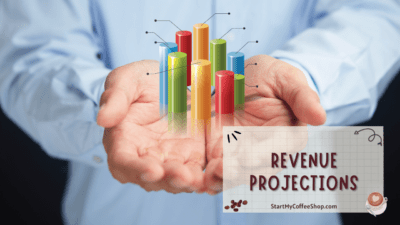
Revenue projections are a crucial aspect of planning and managing a coffee shop, and a coffee shop startup costs spreadsheet facilitates the estimation of your expected sales. By considering various factors and utilizing relevant data, you can develop realistic revenue projections to guide your business decisions. Here’s how a coffee shop startup costs spreadsheet can assist in creating revenue projections:
Read more about: Coffee Shop Start-Up Costs: Counting Cups and Coins
- Firstly, you can forecast your expected sales by taking into account factors such as your coffee shop’s location, target market, pricing strategy, and competition. Assessing the demographics and preferences of your target customers can help you estimate the demand for your products and services. Additionally, considering your location’s foot traffic, proximity to residential or business areas, and competitive landscape aids in projecting sales volume accurately.
- Secondly, historical data, market research, and industry benchmarks play a vital role in estimating your initial revenue. By analyzing data from similar coffee shops or your pre-launch activities (e.g., pop-up events or market testing), you can gain insights into potential sales performance. Market research helps identify trends, customer preferences, and market saturation, enabling you to make informed assumptions about your coffee shop’s revenue potential. Industry benchmarks provide reference points for evaluating your projected sales against established norms in the coffee shop industry.
Breakeven Analysis
Breakeven analysis is a critical tool for assessing the financial viability and profitability of your coffee shop, and a coffee shop startup costs spreadsheet enables you to perform this analysis effectively.
By calculating the breakeven point, you can determine the minimum sales volume needed to cover all your expenses and reach a point of profitability. Here’s how a coffee shop startup costs spreadsheet can assist in conducting a breakeven analysis:
- Firstly, the spreadsheet allows you to input and organize your coffee shop’s total revenue and total expenses. This includes fixed costs (such as rent, insurance, and loan payments) and variable costs (such as ingredients, supplies, and labor expenses). By tracking and categorizing these expenses accurately, the spreadsheet provides a comprehensive view of your cost structure.
- Secondly, utilizing the revenue projections discussed earlier, the spreadsheet enables you to calculate the breakeven point. The breakeven point is the sales volume at which your coffee shop’s total revenue equals total expenses, resulting in neither a profit nor a loss. By subtracting your total expenses from your total revenue, you can determine the number of sales or the sales value required to cover all costs.
Creating Your Coffee Shop Startup Costs Spreadsheet
Creating a startup costs spreadsheet for your coffee shop involves several key steps to ensure accuracy and effectiveness. Here is a detailed guide on how to create a comprehensive coffee shop startup costs spreadsheet:
- Gather Information: Begin by conducting thorough research on the coffee shop industry. Explore industry norms, local market conditions, supplier costs, and other relevant data to obtain accurate information for your spreadsheet. This research forms the foundation of your financial projections.
- Identify Categories: Categorize your expenses into logical groups to ensure organization and clarity. Common categories include pre-opening expenses, operational costs, fixed and variable expenses, and revenue projections. This categorization helps you understand the different components of your coffee shop’s financial landscape.

- Assign Costs: Assign realistic values to each expense item based on your research and estimates. Be diligent in capturing both one-time expenses and recurring costs. This includes everything from equipment and supplies to permits and employee salaries. Take the time to gather accurate cost information to ensure your projections are as precise as possible.
- Include Formulas: Utilize formulas in your spreadsheet to automate calculations and ensure accuracy. Use formulas, to sum up expenses within each category, calculate the total startup costs, and project revenue based on different sales assumptions. Formulas provide a dynamic and efficient way to update your financial projections as variables change.
- Consider Contingencies: Factor in contingencies by allocating a percentage of your total budget as a buffer. This buffer accounts for unexpected costs, market fluctuations, or unforeseen challenges. It is essential to include contingencies to safeguard your financial stability and mitigate risks.
- Review and Update: Regularly review and update your spreadsheet as you gather more information and refine your business plan. As you progress with your coffee shop startup, you will gain additional insights and make adjustments to your financial projections. Keep your spreadsheet up to date to reflect the latest data and ensure accurate financial planning.
Read more about: Coffee Shop Start-Up Costs: Behind The Counter
Summary
A coffee shop startup costs spreadsheet is a valuable tool that helps you navigate the financial aspects of launching and running your coffee shop. By meticulously accounting for all expenses, projecting revenues, and conducting breakeven analysis, you can make informed decisions and increase your chances of progress.
Remember, your spreadsheet should be dynamic, adaptable, and regularly updated to reflect changing circumstances. So, grab your favorite brew, start crunching those numbers, and bring your coffee shop dream to life!
Frequently Asked Questions
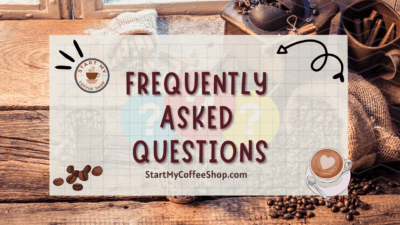
Q: Why is a coffee shop startup costs spreadsheet important?
A: A startup costs spreadsheet helps you understand your financial obligations, create budgets, and make informed decisions for your coffee shop venture.
Q: What components should be included in a coffee shop startup costs spreadsheet?
A: Key components include pre-opening expenses, operational expenses, fixed and variable costs, revenue projections, and break-even analysis.
Q: How do I create a coffee shop startup costs spreadsheet?
A: Gather accurate information, categorize expenses, assign costs, include formulas for calculations, consider contingencies, and regularly update the spreadsheet.
To learn more on how to start your own coffee shop, check out my startup documents here.
Disclaimer: The information provided by StartMyCoffeeShop.com (“The Site”) is for general informational purposes only. All information on the Site is provided in good faith. However, we make no representation or warranty of any kind, express or implied, regarding the accuracy, adequacy, validity, reliability, availability, or completeness of any information on the Site. Under no circumstance shall we have any liability to you for any loss or damage of any kind incurred as a result of the use of the Site or Reliance on any information provided on the Site. Your use of the Site and reliance on any information on the Site is solely at your own risk. This blog post is for educational purposes only and does not constitute legal advice. Please consult a legal expert to address your specific needs. Terms and Conditions. (https://startmycoffeeshop.com/terms-and-conditions/)

Hi! I’m Shawn Chun
My adventure in coffee began when I first launched my first coffee shop back in the early 2000s. I had to figure out so many things on my own and to make it worse within 2 years of opening two large corporate coffee chains moved in just blocks away from me!
As I saw smaller and even some larger coffee shops in the neighborhood slowly lose customers to these giant coffee chains and slowly close up shop, I knew that I had to start getting creative…or go out of business.
I (like you may be) knew the coffee industry well. I could make the best latte art around and the foam on my caps was the fluffiest you have ever seen. I even had the best state-of-the-art 2 group digital Nuova Simonelli machine money could buy. But I knew that these things alone would not be enough to lure customers away from the name brand established coffee shops.
Eventually, through lots of trial and error as well as perseverance and creativity I did find a way to not only survive but also thrive in the coffee/espresso industry even while those corporate coffee chains stayed put. During those years I learned to adapt and always faced new challenges. It was not always easy, however, in the end, I was the sole survivor independent coffee shop within a 10-mile radius of my location. Just two corporate coffee chains and I were left after that year. All told the corporate coffee chains took down over 15 small independent coffee shops and kiosks and I was the last one standing and thriving.
Along the years I meet others with the same passion for coffee and I quickly learned that it is not only “how good a barista is” that makes a coffee shop successful, but the business side of coffee as well.
Hence why I started this website you are on now. To provide the tools and resources for up and coming coffee shop owners to gain that vital insight and knowledge on how to start a coffee shop successfully.
Stick around, browse through my helpful blog and resources and enjoy your stay! With lots of LATTE LOVE!
Shawn

